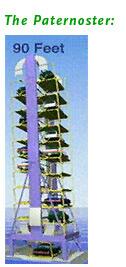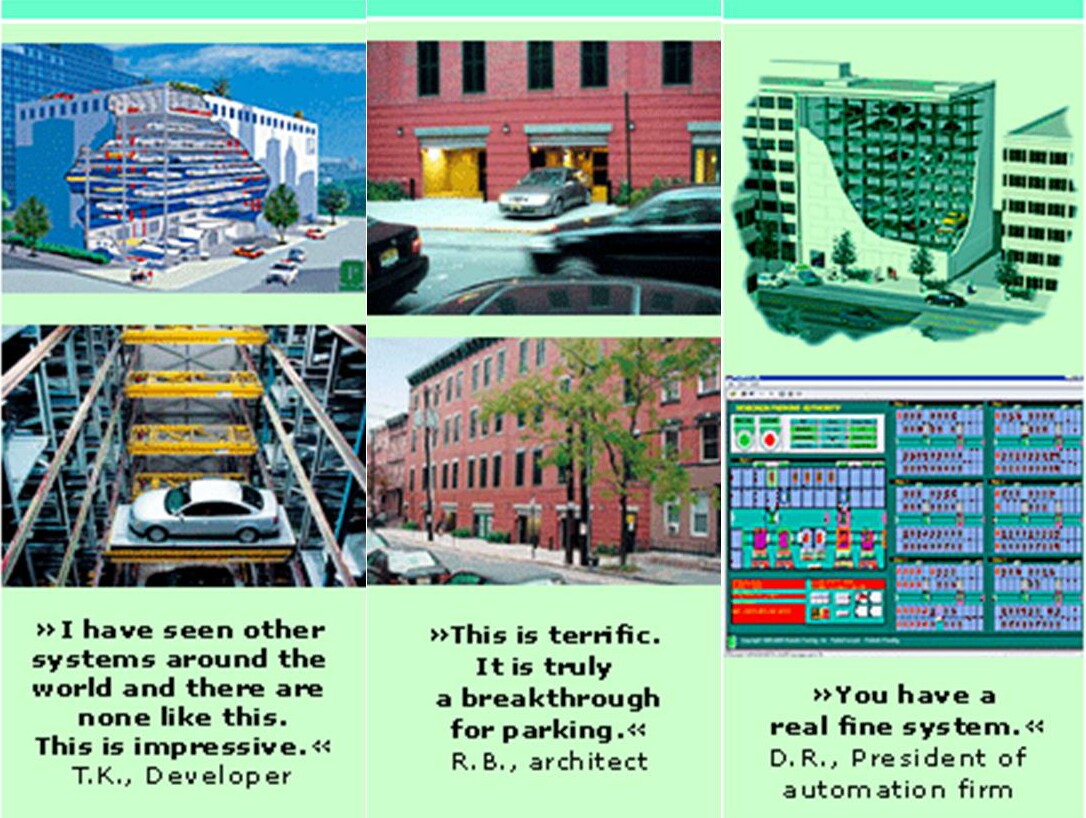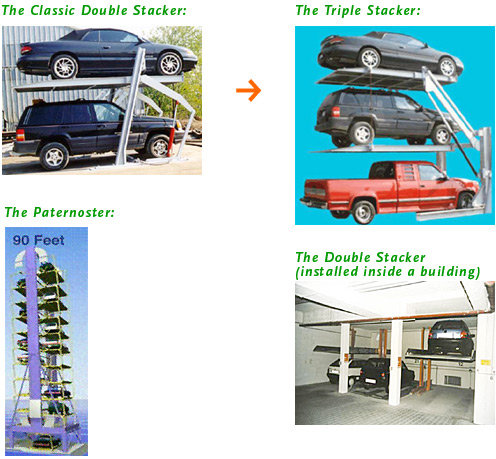Robotic Parking
MECHANIZATION IN PARKING TODAY
In today’s highly mechanized and electronic computer driven society the term automated parking has emerged to differentiate and define the higher technology methods of parking vehicles.
The Webster’s Dictionary defines “Mechanical” as: produced or operated by a machine or tool. The concept is that one has only to push a button, or a sequence of buttons or levers in order to initiate a single motion, or to begin a connected sequence of mechanical movements that are then performed by one machine or device. This, of course, is a wide definition. It could be the push of a button in an elevator or lift, which then moves to a number of floors. It could also be the push of a button, which initiates a new sequence of movements directly connected to each other. For example, if the device “A” moves clockwise, then device “B”, which is directly mechanically connected to “A”, will lift a platform from level 1 to level 2. Or it could be a parking wheel which has an inherent set of motions, and which will always be in the exact same positions or set motions upon an initiation of a button or lever.
Overview Of Automatic Parking Systems
KEY ELEMENTS
In this chapter we want to describe the key elements used in the different systems. The reader should achieve a simple and comprehensive grasp of the subject. We will lay out the key elements and then show in a diagram how they are combined in respective systems/combinations in use today in various locations across the world.

![]()
This picture shows a stack of 4 pallets on top of each other. Note the depressions for
collecting water (melted snow) or other liquids
that may drip from the car. Also note the wheel
stops to prevent the vehicle from rolling.
Mechanized parking developed from simply transporting cars with freight elevators from floor to floor with an operator driving on and off the lift platform to the parking floors. The floors were always a stable platform. With advancing technology for storing and retrieving cars, came the need to use an element that substitutes for these stable decks or platforms. The so called “PALLET” was introduced.
A pallet is basically a substitute platform onto which the vehicle is driven. It is not fixed like concrete decks. It is a moveable stable plate. Several ‘problems’ were solved with this development:
1) The stable platforms, usually cast-in-place concrete, were now replaced by a movable and flexible plate, with dimensions of approximately about 7 x 19 feet – sufficient to accommodate the dimensions of most automobiles.
2) No machinery needs to touch the car since the pallet is picked up from underneath itself after the car has been parked on the top of the pallet.
3) The differences in car sizes, wheel dimensions, wheel basis, front and rear overhangs and the tire widths ranging from 5 to 15 inches could be handled by a properly designed pallet. Differences do not represent any barrier. As long as the vehicle fits onto the pallet, the vehicle is now protected from any contact as the machinery touches the pallet from below and the pallet is always bigger than the vehicle itself. No other element inside the garage comes close to the car. If this would ever occur, the pallet is there to protect the vehicle from any lateral contact.
4) A fourth and major advantage is that the pallets on which the cars rest are identical. Thus the machinery does not need adjustments to handle various sizes. The pallets have the same fixed dimensions and are moveable.
Another important feature inherent with the introduction of pallets is that any drippings, either from the engines, the fuel tanks or the snow and salt residuals from the environment are now being captured by the pallets. They protect other machinery, other vehicles and the structure from this debris. The pallets themselves are easily washed when dirty and any debris can be easily collected and disposed of properly. The washing of palettes can be automated as well.
Additionally, the need for concrete floors or other decking disappears. Often the pallets are designed to provide drive-in guidance and wheel stops as well so that the car cannot roll off during the machineries’ x, y and z movements - in case the patron forgets to set the brake or puts the gear in neutral.
A very important argument for using pallets (at least in some countries today) is to minimize product liability as the danger of an element inside an automated parking facility touching the car is averted.
TONGS or COMB
Some system designers, in countries where automated parking has become commonplace, have chosen not to use pallets but instead use tongs or so called grippers which grab the tires from the front and the rear thus capturing the vehicle for transport. A so called trolley drives underneath the car and swings 8 tongs out under each tires in such a way as to capture all the tires front and back and then move the vehicle.

Another pallet-less system is the Comb system. The name explains it. It is a two fold comb – one stationary and the other comb moving between the fingers of the stationary comb during lifting thus capturing the tires of the vehicle and moving it through the system to its designated parking space. The name stems literally from the ‘comb’. Ypu can see how this works if you can envision taking two combs and moving them offset to each other through themselves.
Comb System Examples


THE PATERNOSTER
 The paternoster system is composed of serial parking spots on an endless vertical chain that looks like a thin rectangular Ferris wheel – see illustration.
The paternoster system is composed of serial parking spots on an endless vertical chain that looks like a thin rectangular Ferris wheel – see illustration.
• System is a niche market product
• Number of parking spots is limited – between and 24 and 32 per system.
• Small footprint of about 22 x 25 feet and up to 90 feet high
• All cars need to be shifted to access a single car and that creates:
• Consumption of energy
• Wear out of movable parts
• Noise
• The loadfull platforms are located on the circle / paternoster.
 Review of Current Mechanical Parking Systems
Review of Current Mechanical Parking Systems
The machine lifts up one vehicle on a platform and a second vehicle parks under the one that is lifted this providing space for two cars in one parking space. Three parking spaces can be created by stacking the cars in a design where one space is down and one is up and one in the middle. The main characteristics of this parking system basically are:
• Recyclable
• Easy to install
• Inexpensive when used in small number of lots
• Not suitable for extreme exterior climate conditions
• Requires very careful parking
• It is not useful for all types of cars
• It requires the removal the bottom car if the upper car is needed by an operator
Some samples should help with the visualization of stacker technology.

If you are interested in a quote-Click Here

Contact Tweraser Group at 954 379 6811
or at info@tweraser.com.
